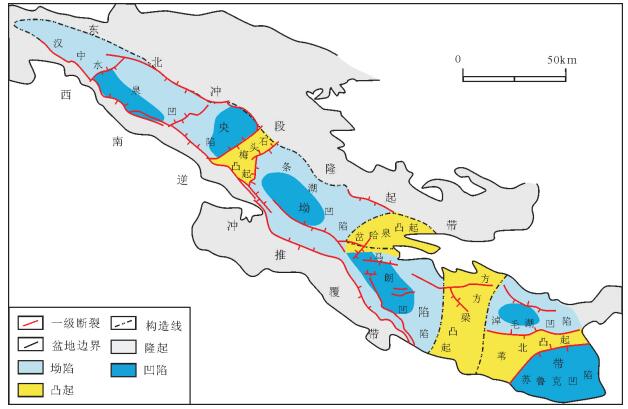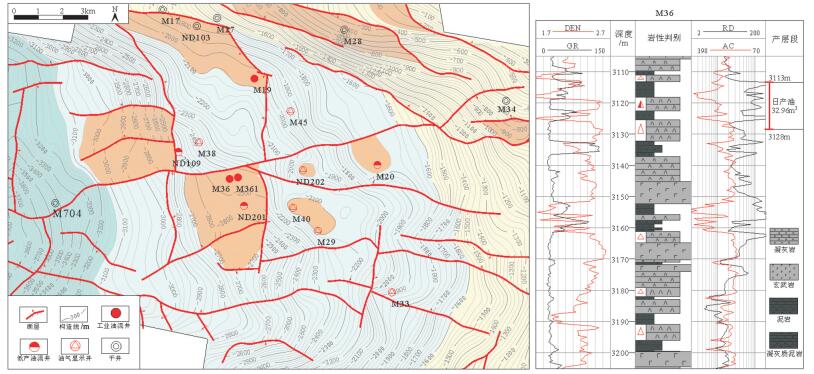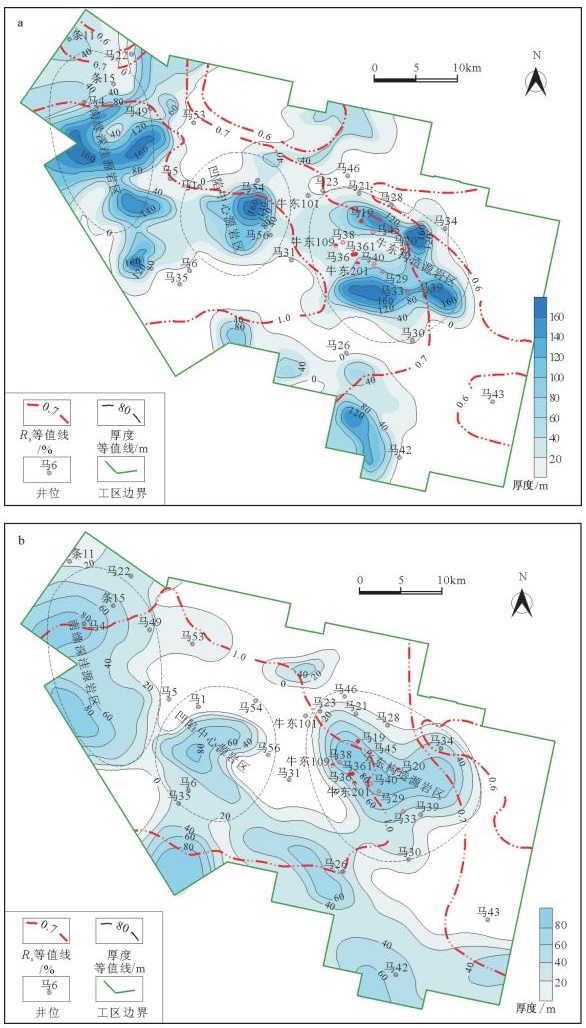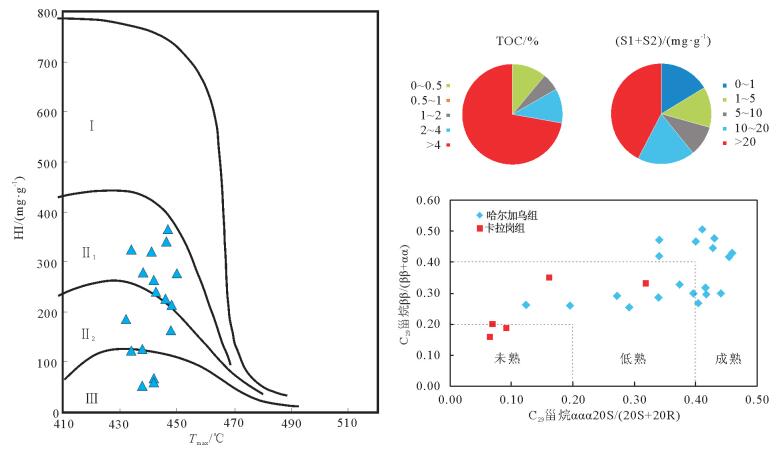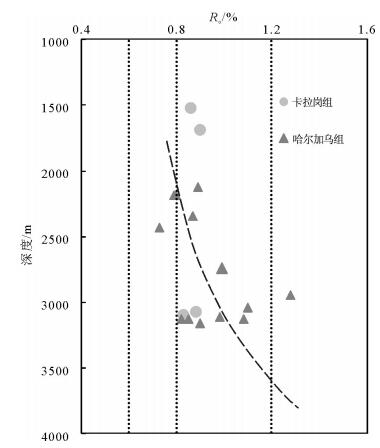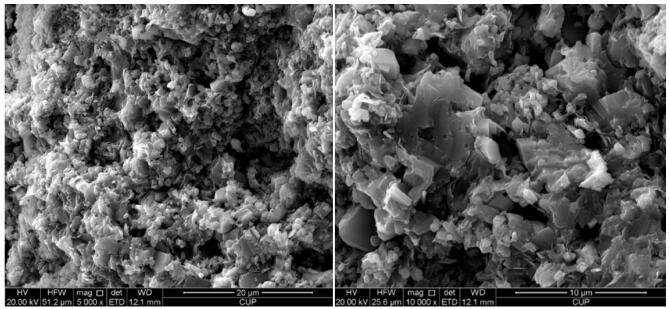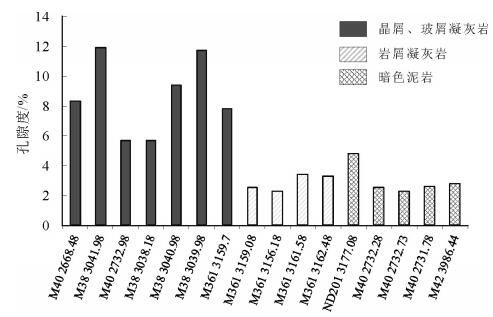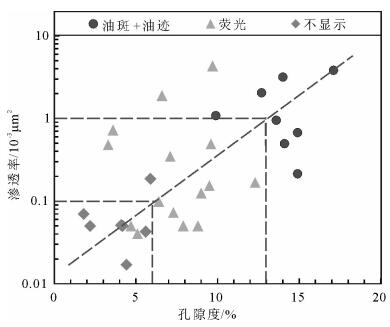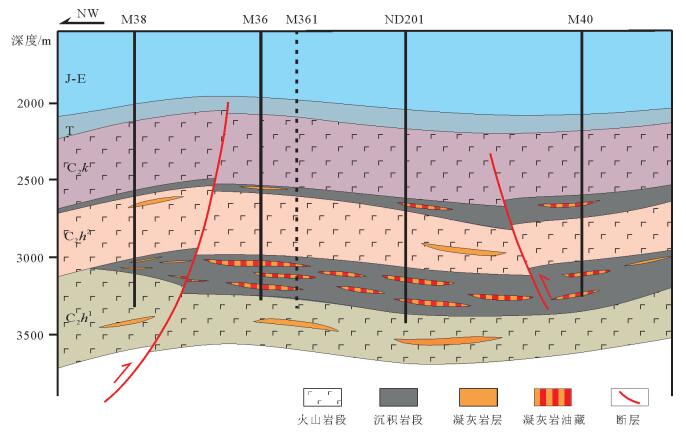The formation conditions of the Upper Carboniferous near-source tuff tight oil reservoir in Santanghu Basin, Xinjiang province
-
摘要:
三塘湖盆地上石炭统烃源岩是火山喷发环境下形成的,烃源岩往往与厚度不等的凝灰岩交互出现,但凝灰岩致密储层的厚度和物性差异较大,源储关系较复杂,因而近源凝灰岩致密油藏的形成需要特定的条件。为了认识三塘湖盆地上石炭统近源凝灰岩致密油藏的形成条件,以典型致密油藏M36为例,综合运用岩心、薄片、测录井、地球化学测试等资料,对成藏要素进行解剖,建立上石炭统凝灰岩致密储层及烃源岩有效性的评价标准,并总结出近源致密油藏成藏模式。结果表明,储层孔隙度大于5%、对应渗透率大于0.07×10-3μm2的凝灰岩可以作为有效储层;烃源岩有机碳含量在4.0%以上,对应生烃潜量大于10%,且Ro大于0.8%的高炭泥岩、暗色泥岩为优质烃源岩;较好的储层、优质的烃源岩和互层型源储配置关系是近源凝灰岩致密油藏的形成条件。
Abstract:The source rock of the Upper Carboniferous strata in Santanghu Basin was formed in the environment of volcanic eruption, which results in alternate occurrence of source rock and tuff with unequal thickness. The tuff tight reservoirs vary both in thickness and in physical property, and the contact relationship between tuff reservoir and source rock is complicated. Therefore, the formation of the near-source tuff tight oil reservoir requires special conditions. To investigate the accumulation conditions of the Upper Carboniferous near-source tuff tight oil reservoir in Santanghu Basin, the authors analyzed M36 which serves as a typical tight oil reservoir. The evaluation standards of the Upper Carboniferous tuff tight reservoir and source rock in Santanghu Basin were established based on the analysis of core, slice, logging, as well as well geochemical testing, and the accumulation model of nearsource tuff tight oil reservoir was also established. The results indicate that, where reservoir porosity is 5%~12% and permeability is 0.07~0.7×10-3μm2, the tuff reservoir can be called high-quality reservoir. The carbonaceous mudstone and dark mudstone whose organic carbon content is higher than 2.0%, and Ro is higher than 0.6% are effective hydrocarbon. Good reservoir, high quality source rock and interbedded source rock-reservoir collocation constitute the formation conditions of near-source tuff tight oil reservoir.
-
Keywords:
- Malang depression /
- Upper Carboniferous /
- tuff /
- tight oil reservoir /
- accumulation condition
-
西天山造山带作为中亚造山带的重要组成部分,记录保存了古生代多地体俯冲增生造山过程和显生宙大陆地壳生长的诸多信息[1-5],是研究增生型造山带的良好载体。长期以来,古亚洲洋(天山洋)的闭合时限一直是地学界争论的焦点,具有晚志留世—泥盆纪[6]、中晚泥盆世[7]、晚泥盆世—早石炭世[8-11]、晚石炭世末[2, 12]和晚二叠世—中三叠世[13-15]等不同认识,归纳起来可分为前石炭世、早石炭世、晚石炭世和后石炭世4种截然不同的观点,因此,石炭纪构造演化过程是研究上述问题的突破口。前人多集中于高级变质岩[16]、大洋岩石圈残片(即蛇绿岩)[17]、不同成因和类型火山岩[18-19]等的研究,而地层接触关系,尤其是区域性角度不整合被认为是构造演化阶段划分的重要依据,地学界趋于认同研究区石炭系与前石炭系的区域型角度不整合[20],但对于石炭系内部尤其是上、下石炭统之间是否存在角度不整合争议颇大[21-23]。
例如,1:20万昭苏幅①将上、下石炭统划为不整合接触,李永军等也将特克斯达坂地区的石炭系各地层均厘定为角度不整合接触[22],而1:20万莫合尔幅②(昭苏幅东侧邻区)将下石炭统阿克沙克组和伊什基里克组划为整合接触。1:20万伊宁幅③下石炭统阿克沙克组的岩石组合为碳酸盐岩、砂岩、砾岩、晶屑岩屑凝灰岩、英安岩、流纹岩、玄武岩等多种岩性组合,并认为盛产腕足和珊瑚化石,较多酸性、中性和基性火山岩的出现与阿克沙克组标准剖面岩性并不完全吻合[24],故有必要对其在伊什基里克一带划定的阿克沙克组进一步解体并重新厘定。部分学者在伊犁特克斯达坂地区厘定出了诸多不整合,对此提出了天山地区至少有6幕褶皱运动的认识[22],认为天山地区早、晚石炭世之间存在一次大的洋盆闭合事件,且早石炭世晚期可能存在构造转换[2, 12, 21, 25]。近期部分学者通过伊犁盆地石炭纪火山-沉积序列的精细研究,认为石炭纪内部各组之间为火山喷发不整合或整合接触关系,为一套火山喷发的正常沉积充填序列[23]。故不同学者及区域地质调查工作者对西天山伊犁地区上、石炭统之间的区域性角度不整合尚存争议,制约了西天山石炭纪构造演化乃至天山洋盆闭合时限的研究。近年来,笔者所在的团队对新疆伊犁地区石炭系主要剖面进行了基础地质调查,本文拟通过对伊犁地区特克斯北部的伊特公路北和萨尔不顺2条剖面,依据下石炭统阿克沙克组和上石炭统伊什基里克组野外沉积学和室内岩相学观察,开展火山-沉积序列的精细研究,分析上、下石炭统的接触关系,为西天山石炭纪构造背景与盆地演化过程提供沉积学依据。
1. 区域地质背景
研究区总体位于中亚造山带西南段(图 1-A),大地构造位置处于伊犁-中天山地块之上,夹持于北天山和南天山早古生代造山带,分别以中天山北缘断裂和南部尼古拉耶夫-那拉提北坡断裂为界[26-27](图 1-B)。本文基于早石炭世(也有学者认为是晚泥盆世—早石炭世)大哈拉军山组区域性角度不整合于下伏前寒武纪中天山结晶基底或前石炭纪褶皱基底之上[2, 23, 30]的地质事实,认为西天山伊犁地区下石炭统下部的区域性角度不整合代表着碰撞后裂谷的“起点”[23],下石炭统发育自下而上的退积型沉积序列,且由扇三角洲向浅海相过渡,具备后碰撞裂谷的递进伸展裂陷的充填特征[31],西天山石炭纪为后碰撞裂谷盆地[23, 31]。
2. 地层及岩性特征
研究区石炭系分布广泛,自下而上可划分为4套岩石组合,分别为大哈拉军山组(C1d)中酸性火山岩-火山碎屑岩、阿克沙克组(C1a)碳酸盐岩-碎屑岩、伊什基里克组(C2y)火山岩、东图津河组(C2dt)海陆交互相碎屑岩夹碳酸盐岩组合和科古琴山组(C2k)陆相粗碎屑沉积[32]。
(1)大哈拉军山组(C1d)
大哈拉军山组分布于博罗科努山南坡、那拉提山、阿吾拉勒山、昭苏县和特克斯县北的伊什基里克山南坡及特克斯县南的大哈拉军山一带[33]。火山岩时空分布具有明显的水平或横向分带特征。由于基底性质不同,西段盆地范围大, 沉积厚度大,向东地层厚度逐渐减薄,且存在由东向西时代变新的趋势[34],总体表现为2套岩性沉积,一套以中酸性火山岩及碎屑岩为主,分布面积大,位于巩乃斯裂谷带外侧;一套为中基性熔岩及碎屑岩,位于以巩乃斯河为中心的内带。地层厚度表现为自西向东、自外带向内带增厚。地层展布显示,从西向东层位增高,时代进一步变新,所以是一个“穿时”地层,向东时限越来越高。岩石组合序列在伊犁-中天山地块不同位置存在一定的差异性。岩层中正常沉积碎屑岩夹层极少见,显示火山活动较连续。
(2)阿克沙克组(C1a)
阿克沙克组主要分布在伊宁盆地北缘的博罗霍洛山和盆地中部的中央隆起(乌孙山-伊什基里克山)一带。总体为一套正常沉积的陆-浅海相碎屑岩和浅海相碳酸盐岩,少见火山岩夹层[24]。典型岩性为厚层的含生物碎屑泥微晶灰岩、颗粒灰岩、生物灰岩、鮞粒灰岩。自下而上分为4个岩性段:下部为灰绿色、灰色厚层细砂岩、粉砂岩、泥质粉砂岩等细碎屑岩,砂岩层发育大型交错层理,以浅海陆棚相为主;中下部发育厚层灰岩、含生物碎屑灰岩、生物礁灰岩、台缘斜坡角砾岩等,化石极丰富,以腕足和四射珊瑚为主,代表了碳酸盐岩台地沉积环境;中上部发育由多个以灰色、灰褐色薄层状粉砂岩、泥质粉砂岩和泥岩粒序层为基本单元的厚层复理石建造,层序底部发育槽模,可见包卷层理,该时期存在较深水沉积环境;上部发育厚层灰黑色泥岩、粉砂质泥岩、含生物化石泥岩,是较深水沉积环境的延续,水体较安静,为陆棚边缘盆地相沉积,是阿克沙克组烃源岩主要发育层段,阿克沙克组在尼勒克北于赞一带则以粗碎屑岩为主,碳酸盐岩仅呈层状产出,表现为扇三角洲相沉积[35]。
(3)伊什基里克组(C2y)
伊什基里克组主要分布在阿吾拉勒山、博罗霍洛山南坡,呈北西—南东向展布,为一套海相喷发岩,岩性较杂,几乎包含基性-中酸性熔岩、火山碎屑岩、沉火山碎屑岩各种类型,夹正常沉积碎屑岩。该组以中-酸性火山岩为主,主要岩性包括灰色、灰紫色安山岩、英安岩、流纹岩、中酸性火山角砾岩、晶屑岩屑凝灰岩、火山灰凝灰岩、沉凝灰岩,局部见橄榄绿玄岩、玄武安山岩、石英斑岩、霏细斑岩。
(4)东图津河组(C2dt)
研究区东图津河组分布于博罗霍洛山、汗古尕山一带,为一套海相碳酸盐岩和碎屑岩沉积,包含灰色-黑色灰岩、大理岩化灰岩夹粉砂岩、砂岩、板岩、页岩和砾岩。东图津河组为伊什基里克组的同期异相沉积。
3. 上、下石炭统整合接触的沉积学证据
本次选取特克斯北部的伊特公路北和萨尔不顺2处露头,对下石炭统阿克沙克组和上石炭统伊什基里克组的接触关系进行详细观察(图 1、图 2、图 3),并建立了沉积充填序列(图 4)。下面就伊特公路和萨尔不顺2个观察点的地层接触关系进行分述。
3.1 伊特公路北
该观察点位于特克斯县城北卡拉沙依一带,出露地层为1:20万昭苏幅划定的下石炭统阿克沙克组和上石炭统伊什基里克组(图 2)。
上、下石炭统接触面两侧岩性为阿克沙克组浅灰色中薄层状含生物碎屑砂质灰岩和伊什基里克组灰绿色玄武岩,产状陡倾(倾角约82°),二者产状一致(图 3),且岩性为渐变过渡关系,阿克沙克组顶部浅灰色中薄层状砂质灰岩中出现灰绿色玄武安山岩砾石(4cm×12cm),砾石呈次棱角状,砂质灰岩中砂质含量约20%,单层厚度约15cm。二者的接触面为火山喷发不整合面,接触面凹凸不平,为喷发覆盖关系,未见底砾岩和风化壳(图版Ⅰ-A),故不存在风化剥蚀作用。沉积序列由下至上分别为:生屑灰岩→砂质灰岩→钙质岩屑杂砂岩→含火山岩砾石的生屑灰岩→含火山碎屑的生物碎屑灰岩→玄武岩→钙质长石岩屑杂砂岩→安山质含角砾熔结凝灰岩(图 2、图版Ⅰ-B)。阿克沙克组顶部灰岩中的火山岩砾石同伊什基里克组火山岩岩性一致。
![]() 图版Ⅰ(B2、B4…为采样点)
图版Ⅰ(B2、B4…为采样点)
A.伊特公路阿克沙克组与伊什基里克组接触关系[23];B.阿克沙克组岩性组合;C.萨尔不顺阿克沙克组与伊什基里克组接触关系;D.灰岩与火山角砾岩接触面;E.灰岩中的火山岩砾石;F.珊瑚化石;G.腕足化石;H.火山角砾岩图版Ⅰ.3.2 萨尔不顺
该观察点位于伊特公路北观察点以东2km萨尔不顺沟西侧采石场(图 1)。原1:20万伊宁福将其划定为阿克沙克组,并未识别出伊什基里克组。本文依据该地区阿克沙克组上部未含火山岩④,将原阿克沙克组进一步解体,萨尔不顺剖面出露的大套火山岩及火山岩碎屑岩组合划定为伊什基里克组,由于受后期南北方向的强烈挤压,该剖面褶皱和断层较发育,故观察点选取阿克沙克组灰岩与伊什基里克组火山岩直接接触部位进行观察。
上、下石炭统接触面为阿克沙克组中厚层状灰褐色含生物碎屑灰岩和伊什基里克组暗紫红色流纹质火山角砾岩,火山角砾岩强烈碳酸盐化,且风化严重。二者产状近直立且一致(倾角约85°),可与伊特公路剖面进行对比,接触面凹凸不平,未见底砾岩和风化壳(图版Ⅰ-C、D、图 3)。接触带附近灰岩中见多个紫红色安山质凝灰岩砾石,大小不一,呈棱角-次棱角,大者可达30cm×15cm,小者可达5cm×2cm(图版Ⅰ-E)。沉积序列由下至上分别为灰白色中厚层状生物碎屑灰岩(含火山岩砾石)→流纹质火山角砾岩→流纹质沉凝灰岩→安山玄武岩→晶屑凝灰岩→含角砾晶屑凝灰岩→流纹岩→安山质晶屑凝灰岩。灰岩中的珊瑚化石(图版Ⅰ-F)和腕足化石(图版Ⅰ-G)指示了浅水碳酸盐岩台地相沉积。伊什基里克组火山角砾岩中可见玄武岩、安山岩和英安岩砾石,砾石呈次棱角-次圆状(图版Ⅰ-H),指示近物源堆积特征。
4. 上、下石炭统整合接触的岩相学证据
本次选取伊特公路北和萨尔不顺2处观察点,在详细观察露头沉积特征的基础上,系统采集下石炭统阿克沙克组和上石炭统伊什基里克组的岩石样品,特别是接触界面附近的代表性岩石和火山岩砾石,对比砾石成分与上覆火山岩地层的差异性。岩相学特征表明,界线附近的阿克沙克组砂质灰岩中含有较多的火山碎屑物质,与露头观察到的阿克沙克组灰岩中赋存的火山岩砾石现象吻合。现将详细岩相学特征进行论述。
4.1 伊特公路北剖面
在该剖面上、下石炭统接触界面附近共采集7件样品,阿克沙克组4件(14YSJLK-B3、B4、B5、B6),伊什基里克组3件(14YSJLK-B2、B8、B9),其中样品14YSJLK-B3为砂质灰岩中的火山岩砾石。
阿克沙克组的代表性岩石组合主要为砂质灰岩、生物碎屑灰岩,夹少量陆源碎屑岩。样品14YSJLK-B4为细粒砂质灰岩,是阿克沙克组典型的岩石类型,呈块状构造,砂状粒状结构,物质组分由方解石、长英质砂屑与岩屑组成(图版Ⅱ-A)。岩屑主要为酸性火山岩岩屑、中酸性火山岩碎屑,粒径细小,一般小于0.2mm(图版Ⅱ-B);长石砂屑为斜长石,多呈次棱角状,少数呈次圆状,粒径一般小于0.2mm;石英砂屑形态、大小与长石砂屑相似;方解石晶体形态多呈不规则粒状,粒径小于0.2mm。
接触面下部为砂质含生物碎屑灰岩(14YSJLKB6),呈块状构造,含生物碎屑砂状结构。岩石中可见较多岩浆岩岩屑,主要为酸性、中酸性火山岩碎屑,其次为安山岩碎屑,碎屑物形态多为次棱角状,少数为次圆状,粒径大小一般为0.15~0.5mm(图版Ⅱ-C)。长石砂屑为斜长石,多呈次棱角状,少数为次圆状,粒径大小为0.1~0.4mm;灰岩碎屑多为泥晶灰岩,形态多不规则,粒径大小在0.15~0.5mm之间;生物碎屑常见有孔虫生物碎屑,呈锥形或盘形,有海百合长方形骨板与圆形基板。
阿克沙克组的陆源碎屑岩组合以细粒钙质岩屑杂砂岩(14YSJLK-B5)为代表,可见较多酸性火山岩碎屑、中酸性火山岩碎屑,碎屑形态呈次棱角状,粒径一般小于0.2mm。长英质砂屑形态呈次圆状或次棱角状,粒径一般小于0.1mm;块状构造,砂状结构,岩屑成分约52%,长石和石英砂屑小于10%,钙质胶结物约38%。阿克沙克组生物碎屑灰岩可见火山岩砾石,岩性为蚀变安山玄武岩(14YSJLK-B3),与上覆伊什基里克组岩性一致。岩石为斑状结构,块状构造,斑晶由斜长石组成,含量为18%~20%,矿物晶体呈板状或粒状,粒径大小在0.5~2.5mm之间,矿物晶体多分散分布,少数呈聚斑出现(图版Ⅱ-D)。基质由斜长石、辉石、金属矿物与火山玻璃组成,斜长石矿物晶体呈小板条状杂乱分布,其空隙被辉石小晶体、金属矿物、火山玻璃充填,呈间粒间隐结构。火山玻璃已脱玻化,被细小帘石交代,细小辉石也被闪石交代。
伊什基里克组代表性岩石组合为玄武岩和安山质含角砾熔岩,本次选取14YSJLK-B2和14YS⁃ JLK-B9两件典型岩石样品开展岩相学研究。其中玄武岩(14YSJLK-B2)为块状构造,斑状结构,基质为间粒结构,斑晶为斜长石,含量约20%,呈板状或粒状,粒径大小在1~2.5mm之间,有时呈聚斑出现。基质由斜长石、辉石、金属矿物钛铁矿组成,斜长石矿物晶体呈小板条状,粒径达0.5mm(图版Ⅱ-E)。安山质晶屑熔结凝灰岩(14YSJLK-B9)呈块状构造,熔岩为含角砾凝灰结构,物质组分由角砾、岩屑、晶屑与熔岩组成。角砾成分为安山岩,呈次棱角状、熔蚀状,粒径大小在2~5.5mm之间;岩屑成分也为安山岩,碎屑物形态呈棱角状、次棱角状、溶蚀状,粒径大小在0.15~0.4mm之间,碎屑胶结物为安山质熔岩(图版Ⅱ-F)。
综上所述,阿克沙克组灰岩中安山玄武岩砾石与上覆伊什基里克组玄武岩基本一致,且接触界面附近灰岩中砂质含量较高,可见较多酸性、中酸性火山岩碎屑物质,存在陆源碎屑和火山物质2类物源供给,这与石炭纪火山活动期及间歇期碳酸盐岩台地沉积的构造背景吻合。
4.2 萨尔不顺剖面
该剖面共采集10件样品,阿克沙克组4件(14SEB-B5、B9、B10、B11),伊什基里克组6件(14SEB-B3、B4、B6、B7、B8、B12)(图 5)。上、下石炭统接触界面附近的生屑灰岩和安山质火山角砾岩均不同程度地表现为碳酸盐岩和火山物质的混合沉积现象,生屑灰岩中见较多火山碎屑,安山质火山角砾岩碳酸盐化明显,与伊特公路北的观察点认识一致。
现选取上、下石炭统界线附近的岩石开展岩相学分析,其中该剖面阿克沙克组岩石组合为生物碎屑灰岩(含腕足、珊瑚、海百合茎化石),为阿克沙克组典型岩石类型(14SEB-B9),岩石为块状构造,碎屑结构。物质组分主要为方解石碎屑与生物碎屑,其中生物碎屑主要为海百合茎,常见矩形骨板,长度达1mm。另见海百合圆形基板,中间有基孔,基板直径达1mm(图 5-A)。
阿克沙克组顶部为生物碎屑灰岩(14SEB-B5),含有火山碎屑(10%),种类为酸性火山岩碎屑,形态多为次棱角状,粒径大小在0.1~0.5mm之间,碎屑胶结物为亮晶方解石(图 5-B)。岩石为块状构造,碎屑状结构,物质组分主要由灰岩碎屑、凝块石碎屑组成,其次为方解石碎屑、生物碎屑等细小岩屑。灰岩碎屑多为泥晶灰岩碎屑,形态不规则,凝块石碎屑呈褐色,碎屑物形态多呈次棱角状,粒径大小在0.3~0.5mm之间,方解石碎屑形态多为次棱角状,粒径大小在0.1~ 0.25mm之间。生物碎屑主要为有孔虫碎屑,个体呈长方柱形或圆形,形体一般较小,可见数个房室。
伊什基里克组岩石组合为安山玄武岩、流纹岩、流纹质火山角砾岩、流纹质沉凝灰岩、安山质晶屑凝灰岩的火山岩和火山碎屑岩组合,本次选取接触界面附近的14SEB-B8和14SEB-B12两件岩石样品开展岩相学研究。样品14SEB-B8岩石类型为流纹质火山角砾岩,角砾含量大于90%,火山角砾成分为流纹岩,碎屑形态为棱角-次棱角状,砾径大小在2~7.2mm之间,凝灰质胶结(图 5-C)。另外,伊什基里克组下段可见碳酸盐化流纹质沉凝灰岩(14SEB-B12),岩石的物质组分主要由火山凝灰物与碳酸盐矿物组成,火山凝灰物主要为流纹岩碎屑、形态多呈不规则状,粒径大小在0.1~0.6mm之间,还有较多玻屑,形态多呈多角状、鸡骨状、弧面状等,已被方解石交代,但保留其玻屑假象。晶屑少量,种类为石英,形态多呈棱角状与次棱角状、粒径大小在0.1~0.3mm之间。火山凝灰物在岩石中的含量大于50%,方解石呈粒状,粒径大小在0.06~ 0.15 mm之间,为火山凝灰质胶结物(图 5-D)。
5. 讨论
地层作为造山带构造演化过程的沉积响应,可以客观记录并有效划分不同构造层,上、下石炭统之间是否存在区域性角度不整合关系到西天山石炭纪构造演化阶段能否“二分”或为统一裂谷盆地这一关键科学问题。本文基于伊犁地区伊特公路北和萨尔不顺2个观察点,着重开展上石炭统伊什基里克组和下石炭统阿克沙克组的地层接触关系研究,以沉积序列为突破口,开展精细的沉积学和岩相学观察。
5.1 火山-沉积充填演化过程
伊犁地区上石炭统伊什基里克组主要为一套裂谷期的双峰式火山岩组合,下石炭统阿克沙克组则以稳定的浅水碳酸盐岩台地相灰岩为代表。野外沉积学调查和室内岩相学特征表明,二者不存在角度不整合或平行不整合,产状一致,未见底砾岩和风化壳,特别是在接触界面上、下的岩石组合中,均发现了碳酸盐岩和火山物质的混合沉积现象,阿克沙克组灰岩中的火山岩砾石与上覆伊什基里克组的火山岩岩性基本一致,上、下石炭统之间未见明显的沉积间断,应为同一构造层的产物。另外,在特克斯南库仕台可见阿克沙克组的砾屑灰岩和伊什基里克组的安山岩直接整合接触。在尼勒克北于赞乡可见阿克沙克组生屑灰岩与东图津和组含砾粗砂岩接触,产状一致且未见风化壳沉积。
1:20万昭苏幅区域地质调查工作表明,特克斯县城北卡拉沙依剖面的阿克沙克组除以碳酸盐岩为典型岩石组合特征外,还有较多酸性火山灰凝灰岩,并可见多套砾岩沉积,表明该地区该时期的构造环境火山活动频繁,易造成滑塌砾岩堆积。本次研究表明,所谓“不整合”很可能是裂谷演化阶段火山-沉积作用的典型产物,阿克沙克组和伊什基里克组分别对应石炭纪火山喷发期与间歇期的火山-沉积建造。早石炭世阿克沙克组在东西横向上不连续,表现为局部碳酸盐岩台地特征,灰岩中赋存丰富的腕足(图版Ⅰ-F)、珊瑚(图版Ⅰ-G)和海百合茎化石,指示了浅水的生物礁相沉积。裂谷演化阶段常伴有多期火山岩浆活动,晚石炭世开始,研究区开始出现火山喷发,产生的高粘度富含挥发分的酸性、基性岩浆喷出地表,同时火山灰流或火山碎屑流进入水体并沉积。伴随火山活动的持续和强烈喷发,伊什基里克组的双峰式火山岩覆盖于浅水相的碳酸盐岩台地即阿克沙克组灰岩之上。特别是在二者接触界面附近的灰岩不纯,可见较多砂屑和火山碎屑,这与火山活动引起的较多陆源碎屑和火山物质供给密切相关。故少量火山岩块、陆源碎屑和碳酸盐岩共同沉积,形成介于下石炭统阿克沙克组和上石炭统伊什基里克组之间的沉积序列。综上所述,研究区上、下石炭统之间并不存在沉积间断,应为连续沉积。
综上,伊犁地区的石炭纪火山岩以双峰式火山岩和碱性火山岩为主,其岩性组合和地球化学特征表明,石炭纪盆地属于持续拉张的构造背景。火山岩夹层中的碎屑岩、砾岩和火山碎屑岩含量较多,结构成熟度和成分成熟度较低,指示了火山喷发期复杂的物源供给特征,火山活动间歇期则以滨浅海相的碳酸盐岩台地为代表,产丰富的海相动物化石(菊石、腕足、珊瑚等)。
5.2 盆地演化分析
裂谷环境下(大洋型、陆间型和大陆型)在演化阶段,由于岩浆火山活动的周期性,其充填序列可出现诸多沉积不整合[36],裂谷盆地的充填序列之间可以存在一个由角度不整合经平行不整合过渡为整合的界面[37]。以东非陆内裂谷为例,盆地在演化过程中可发育诸多沉积不整合[36, 38],裂谷演化阶段初期和裂谷期后均可以出现地层不整合[39],故仔细甄别沉积不整合并厘定区域性角度不整合是确定造山事件抑或洋盆闭合时限的关键。
李永军等[32]在研究区厘定出下石炭统阿克沙克组与上石炭统伊什基里克组之间的角度不整合,二者呈微角度相交,应为裂谷盆地期的沉积不整合,而伊什基里克组的火山岩组合则代表新的裂陷期的开始,在裂谷发育演化阶段,岩浆活动频发阶段伴随着剧烈的地壳运动,会对下伏沉积地层造成强烈挤压变形,间歇期地层变形较弱,可以出现局部所谓“不同构造层次”的变形特征组合。前人将上、下石炭统之交作为洋盆闭合的重要关键节点,对应明显的洋陆转换,伊犁特克斯地区下石炭统阿克沙克组为典型滨浅海碳酸盐岩台地沉积,上石炭统伊什基里克组为海相火山岩建造,二者之间并未出现明显的洋陆变迁事件。
伊犁地区石炭纪盆地具备2套伸展-裂陷演化序列,序列Ⅰ、Ⅱ为大哈拉军山组底部的扇三角洲相沉积,向上出现2次爆发相-喷溢相的火山喷发旋回,阿克沙克组为扇三角洲相→滨浅海相→开阔台地相,序列Ⅱ为伊什基里克组的3次爆发相-喷溢相的火山喷发旋回,东图津和组则为浅海陆棚相沉积,具备后碰撞裂谷盆地的充填过程[23],其受控于南、北两侧早古生代造山带,二叠纪研究区完全进入陆内裂谷盆地。盆地动力学机制方面,石炭纪可能与盆山结合带的增厚地壳造成的“去山根”作用有关,使岩石圈地幔和下地壳发生拆沉,导致软流圈热侵蚀、俯冲板片的断离-折返,诱发基性岩浆活动,引起地表短暂抬升后的持续裂陷[40]。二叠纪西天山伊犁地区整体表现为陆相红层,其拉张的动力学机制可能与塔里木地幔柱的远程效应有关[41]。
6. 结论
西天山伊犁地区的地层学调查表明,上、下石炭统为整合接触,沉积学和岩相学特征均表明,阿克沙克组灰岩和伊什基里克组火山岩之间存在火山物质和碳酸盐岩物质“混生”现象,研究区在石炭纪应为统一后碰撞裂谷盆地。
致谢: 审稿专家中国地质调查局西安地质调查中心卢进才教授级高级工程师提出了诸多宝贵建议,受益良多,文章编写和工作中得到中国石油大学(北京)郭小波、马剑博士及油田研究院项目组研究人员的极大帮助,实验室谌志远博士、韩为硕士在实验检测及分析过程中给予的帮助,在此一并致谢。 -
图 3 哈尔加乌组上(a)、下(b)段烃源岩分布及热演化程度分布(据参考文献[16]修改)
Figure 3. The distribution of thermal maturities of source rocks in Haerjiawu Formation
表 1 上石炭统凝灰岩致密油藏烃源岩分类评价指标
Table 1 The evaluation standard of Upper Carboniferous source rock
项目 评价指标 优质 好-中等 差 沉积环境 沉积相
主要岩性泻湖、海湾
高碳泥岩、暗色泥岩滨浅海
暗色泥岩潮坪
凝灰质泥岩烃源岩 厚度/m > 70 30~70 < 30 地质特征 埋深/m 2200~3600 > 3600 < 2200 TOC/% > 4.0 2.0~4.0 < 2.0 烃源岩 (S1+S2/)(mg.g-1) > 10 10~4 < 4 地化特征 有机质类型 Ⅱ1 Ⅱ2 Ⅱ2~Ⅲ 成熟度Ro/% 0.8~1.2 0.6~0.8 > 1.2 表 2 上石炭统凝灰岩致密储层评价标准
Table 2 The evaluation standard of Upper Carboniferous tight tuff reservoirs
项目 评价指标 好 中等 差 岩性特征 土要岩性 玻屑凝灰岩
晶屑玻屑凝灰岩晶屑凝灰岩
玻屑晶屑凝灰岩岩屑凝灰岩 物性特征 孔隙类型 脱玻化孔、晶间溶孔、粒间孔等 晶间溶孔、粒间孔、脱玻化孔等 粒间孔、粒内孔、气孔 孔隙度/% > 12 12~5 < 5 渗透率/10-3μm2 > 0.7 0.7~0.07 < 0.07 表 3 凝灰岩与烃源岩赋存关系分类
Table 3 Classifications of the occurrence relationship between tuff and source rock
类别 单层厚度 形成期 岩性组合 成藏条件 类型模式 近源凝灰岩 厚层凝灰岩 > 15m 喷发间歇期 集中发育于沉积岩层局部 源储关系较好,邻近源岩部位可富油 
互层凝灰岩 3~15m 火山喷发同期 与沉积岩呈近等厚互层产出 源储关系好,有利于成藏和富集 薄层凝灰岩 < 3m 火山喷发同期 夹在沉积岩中的凝灰岩薄层 储层太薄,源储关系差,不利于富集 远源凝灰岩 厚度变化较大 喷发间歇期 呈夹层分布在火山熔岩中 源储条件差,不利于成藏 -
Ledingham G W, Pool S. Kern County, California: Geological note[J]. AAPG Bulletin, 1947, 31(11):2063-2067.
贾承造, 邹才能, 李建忠, 等.中国致密油评价标准、主要类型、基本特征及资源前景[J].石油学报, 2012, 33(3):343-350. doi: 10.7623/syxb201203001 邹才能, 朱如凯, 吴松涛, 等.常规与非常规油气聚集类型、特征、机理及展望——以中国致密油和致密气为例[J].石油学报, 2012, 33(2):173-187. doi: 10.7623/syxb201202001 陈旋, 李杰, 梁浩, 等.三塘湖盆地条湖组沉凝灰岩致密油藏成藏特征[J].新疆石油地质, 2014, 35(4):386-390. doi: 10.3969/j.issn.1673-8926.2015.02.013 马剑, 黄志龙, 刘再振, 等.三塘湖盆地条湖组含沉积有机质凝灰岩致密储层特征[J].地学前缘, 2015, 22(6):185-196. http://d.old.wanfangdata.com.cn/Periodical/dxqy201506014 刘俊田, 陈旋, 李永林, 等.马朗凹陷条湖组致密油藏成藏特征与主控因素[J].天然气技术与经济, 2014, (3):11-14. http://d.old.wanfangdata.com.cn/Periodical/trqjs201403004 冯亚琴, 陈旋, 李杰, 等.马朗凹陷条湖组二段非常规致密储层特征研究[J].新疆地质, 2013, 31(z1):142-146. http://d.old.wanfangdata.com.cn/Periodical/xjdz2013z1027 宋到福, 何登发, 王书荣, 等.三塘湖盆地石炭系烃源岩评价[J].新疆石油地质, 2012, (3):305-309. https://www.wenkuxiazai.com/doc/936a9c927cd184254a35351f.html 周宁超. 三塘湖盆地上石炭统哈尔加乌组烃源岩综合研究[D]. 西北大学硕士学位论文, 2014. http://cdmd.cnki.com.cn/Article/CDMD-10697-1014253563.htm 刘春艳. 新疆三塘湖盆地石炭系烃源岩地球化学特征研究[D]. 兰州大学硕士学位论文, 2009. http://www.wanfangdata.com.cn/details/detail.do?_type=degree&id=Y1517239 肖序常, 汤耀庆, 冯益民, 等.新疆北部及其邻区大地构造[M].北京:地质出版社, 1992:1-47 王绪龙, 唐勇, 陈中红, 等.新疆北部石炭纪岩相古地理[J].沉积学报, 2013, 31(4): 571-579. http://d.old.wanfangdata.com.cn/Periodical/cjxb201304002 李玮, 周鼎武, 柳益群, 等.三塘湖盆地二叠纪构造层划分及其构造特点[J].西北大学学报:自然科学版, 2005, 35(5): 617-620. 李仙蓉. 三塘湖盆地及周边石炭系烃源岩评价[D]. 西北大学硕士学位论文, 2009. http://www.wanfangdata.com.cn/details/detail.do?_type=degree&id=Y1453290 廖卓庭, 吴国干.新疆三塘湖盆地含油气地层[M].南京:东南大学出版社, 1998. 柳波, 贾梦成, 黄志龙, 等.三塘湖盆地马朗凹陷石炭系火山岩系烃源岩识别与预测[J].石油实验地质, 2015, 37(4):452-459. doi: 10.11781/sysydz201504452 吴红烛, 黄志龙, 柳波, 等.马朗凹陷哈尔加乌组烃源岩分布和生烃演化与石炭系成藏关系[J].中国石油大学学报:自然科学版, 2014, 38(1):22-31. http://d.old.wanfangdata.com.cn/Periodical/sydxxb201401004 任收麦, 包书景, 张毅, 等.柴达木盆地北缘侏罗系页岩气地质条件[J].地质通报, 2016, 35(2/3):204-210. http://dzhtb.cgs.cn/ch/reader/view_abstract.aspx?file_no=20160302&flag=1 郭天旭, 包书景, 康志宏, 等.阿尔金山南缘侏罗系页岩气生烃及储集条件[J].地质通报, 2016, 35(2/3):221-230. http://dzhtb.cgs.cn/ch/reader/view_abstract.aspx?file_no=20160304&flag=1 李传亮, 张景廉, 杜志敏.油气初次运移理论新探[J].地学前缘, 2007, 14(4):132-142. doi: 10.3321/j.issn:1005-2321.2007.04.014 王京红, 靳久强, 朱如凯, 等.新疆北部石炭系火山岩风化壳有效储层特征及分布规律[J].石油学报, 2011, 32(5):757-766. doi: 10.7623/syxb201105004 曾联波, 肖淑蓉.低渗透储集层中的泥岩裂缝储集体[J].石油实验地质, 1999, 21(3):266-269. doi: 10.11781/sysydz199903266 李红, 柳益群, 刘延莉, 等.三塘湖盆地条湖、马朗凹陷沉降史分析[J].西北大学学报:自然科学版, 2004, 34(6):721-725. http://d.old.wanfangdata.com.cn/Periodical/xbdxxb200406024 王小凤, 武红岭, 马寅生, 等.构造应力场、流体势场对柴达木盆地西部油气运聚的控制作用[J].地质通报, 2006, 25(Z2):1036-1044. http://dzhtb.cgs.cn/ch/reader/view_abstract.aspx?file_no=200609192&flag=1 李慧. 鄂尔多斯盆地上三叠统延长组深湖沉积与凝灰岩沉积特征研究[D]. 西北大学硕士学位论文, 2009. http://www.wanfangdata.com.cn/details/detail.do?_type=degree&id=Y1453276 邱欣卫, 刘池洋, 李元昊, 等.鄂尔多斯盆地延长组凝灰岩夹层展布特征及其地质意义[J].沉积学报, 2009, 27(6):1138-1146. http://kns.cnki.net/KCMS/detail/detail.aspx?filename=cjxb200906017&dbname=CJFD&dbcode=CJFQ




 下载:
下载:






